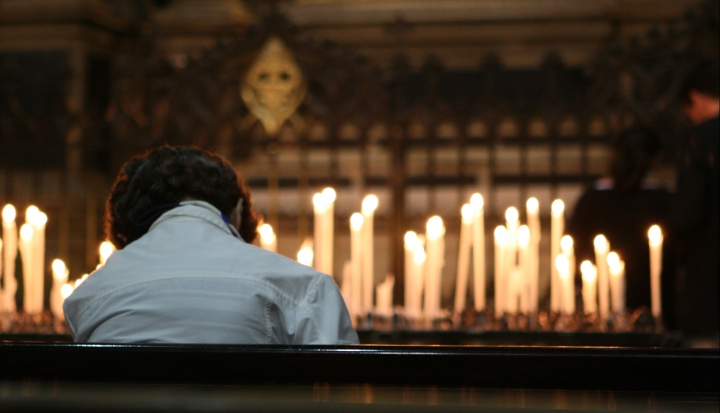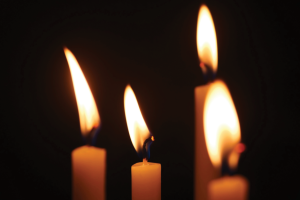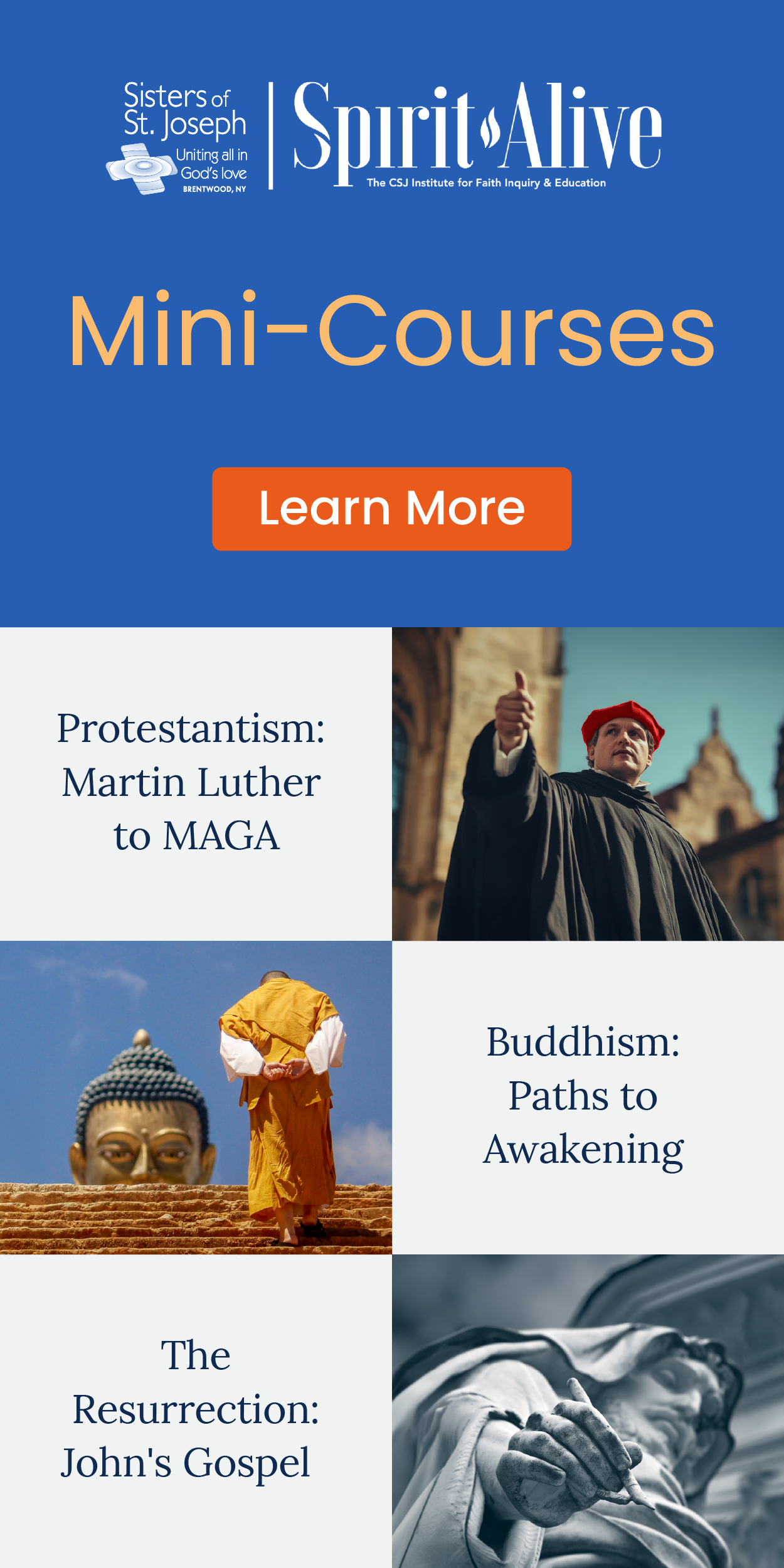Seven steps to simpler (and better) prayer.
By Michael Paul Gallagher
This essay appeared in the May 1990 issue of U.S. Catholic (Vol. 55, No. 5, pages11-13). Reprinted with permission from The Furrow, November 1988, Volume XXXIX, Number 11, pages 689-965.
Probably everyone would agree that personal prayer is meant to become more simple with the years. But this seems to be both obvious in theory and hard to accept in practice. We seem to be conservatives in prayer, often harking back to what used to ‘work’ and feeling disappointed when it seems so seldom to ‘work’ now. So what I want to offer here is a list of ‘transitions’ that seems typical in this process of prayer becoming more simple. Not all of the transitions need apply to any one individual, and certainly they are unlikely to happen all at once. But some of them seem to be part of the experience of many people: to recognize them as normal can help a person to trust his or her experience and to see these invitations as the promptings of the Spirit.
These few paragraphs are not intended as a treatise in spiritual theology nor as a summary of the great experts in prayer. What is intended here is more personal—gathered from my own unsteady efforts to pray and enriched by having had occasion to listen to the experience of others as well.
I relish the story of a colleague of mine who was on a visit to a Carthusian community for some weeks. Towards the end of his stay, his attention was caught by one monk who seemed to radiate a certain inner strength and was even more of a hermit than the other. My friend sought an audience with this holy man and, after telling him of the busy life that he was about to return to, asked advice on how to pray better. The hermit looked at him and said, ‘Pray in, not up.’ And bade him farewell. My friend, after his elaborate outline of his dilemma, was given but four words of wisdom! But that tantalizing reply provides me with the first of the series of ‘transitions’ that I want to suggest as in-built within the usual life-cycle of prayer.
1. From God outside me to God inside me
No doubt God is everywhere, but when I begin to pray, my limited imagination tends to picture the One to whom I come as located somewhere or other. What the Carthusian was suggesting to his client was that he focus on the presence of the Spirit within him. Clearly this advice is rooted in the Scriptures in many places—in the promise of Jesus at the Last Supper that his Spirit would be ‘with’ and ‘within’ his disciples, or the passage in Saint Paul where he envisages the Spirit struggling within us when we do not know how to pray (John 14:17; Rom. 8:26). In short, a new awareness of the indwelling of God in our hearts is one of many simplifications that seems to happen with the years.
2. From ‘God’ to Trinity
There is a parallel invitation to move from God as one to God as three. Putting this personally, I can clearly remember studying the Trinity in theology and indeed doing some ambitious essay on the doctrine as it evolved through the early centuries. But it was years later before it became spiritually alive for me and, in fact, became one of the central enthusiasms of my faith. Probably it was a simple realization that the solemn prayers of the Mass are so rootedly Trinitarian that began slowly to influence my perception of personal prayer. The crucial image here is the gospel picture of Jesus led by the Spirit and praying to the Father on the mountain. Gradually I came to realize that Christian prayer is always an echo of that encounter: I am invited by the Spirit to be with Jesus before the Father. And being with Jesus involves being in solidarity with his people—which links this transition with the two last ones to be outlined below.
3. From speaking to listening
Here is an obvious and often spoke-of growth point in prayer. It is voiced by Jesus himself in the advice not to use many words, but it seems to be one of the crucial thresholds for people in the expansion of their prayer lives. It needs a certain courage to let go of the security of the conversational prayer and of familiar zones of silence. But silence is the language of God, and this transition is a vital step towards a more contemplative level of praying. It means an emergence from self-strength to a trust that God is ‘there’ in all his shyness. One’s own resources have proved painfully incapable of bearing fruit any more (even if they once did). Then it is time to let go of ‘the perpetual monologue of the ego’ (Laurence Freeman) and to let down the nets into deeper water.
In my experience, this transition comes slowly—so that prayer can be a mixture of old and new wavelengths. But the wisdom of the contemplative tradition seems unanimous on this point: that a time comes when more ‘chatty’ forms of active prayer become boring sooner or later, and this is usually a sign that it is right to let go of one’s self-controlled agenda and to risk a quieter listening. Unfortunately, many people experience only the sense of strandedness and do not know how to read it as a positive signal to let go. It is sad if they throw in the sponge and abandon the whole enterprise as not-for-them.
4. From forgetting to remembering the body
As a practical help towards that deeper listening, the last decade or two of spiritual writing has seen an explosion of interest in learning from the East and more particularity a popularizing of various skills of stillness that start from the physical.
Many anchors can be suggested to root the scattered self and lead towards the threshold of prayer, for instance the sound of a mantra, the rhythm of one’s breathing, the flame of a candle. What they have in common is an acknowledgment of the bodily basis of being ready to give ‘loving attentiveness’ to God (to use the famous phrase of John of the Cross). Certainly these techniques could degenerate into narcissistic ‘trips’ of consciousness, becoming ends instead of means, with the result that real prayer—as a relationship and dialogue—simply fails to happen.
But dangers aside, this renewed awareness of the body brings many advantages. It can be a practical ‘recollection’ for prayer and indeed a form of reverence for the humanity of each person in body-spirit. In today’s culture with its avalanche of silly images, some such techniques seem crucial as a kind of self-ecology because the environment of our spiritual awareness needs just as much protection from pollution as our rivers and seas. Again, where an older spirituality seemed to ignore the body, these newer versions of wisdom can help people to ground their praying in a steadier silence and to escape what the Zen masters call the ‘cave of conceptualization.’ Thus prayer may have a better chance of going beyond the self-homilies (and often negative self-homilies at that). ‘Lose your mind and come to your senses’ was one of the characteristic Father Anthony de Mello ways of capturing this gateway to listening to God.
5. From asking to offering
Thomas Aquinas says somewhere that prayer is the language of desire, and there is no doubt that prayer of petition is a central strand in the Christian tradition. And yet it is not the whole story. Asking to know the love of God leads on to offering oneself to the struggle of loving. Something of this transition can be found even in the great scene of the Annunciation. Mary is at first the receiver of a gift, indeed a disturbing gift, as Luke stresses. But the scene moves through questions and struggle to surrender. Mary ends by offering herself to the hopes of God. And this note too is a vital one in the chord that is prayer. It is an essential part of the journey of prayer to move towards a fuller degree of availability for God and for the tasks of life—as in the spirit of the concluding offering of the Spiritual Exercises of Ignatius Loyola, “Take and receive… all that I am.”
6. From ‘my’ to ‘our’
Another healthy transition would be from a me-alone-with-God model of prayer to a humbler sense of not being separate from the human drama as I enter a space for prayer. Perhaps a good deal of what we have called ‘personal’ prayer has been in fact so ‘private’ as to be unfaithful to the Lord’s own prayer, which of course begins with the word ‘our.’ In this respect an almost infallible way to liberate prayer from a cul-de-sac of introspection is to have exposure to the suffering of the poor. Even to say this is risky because it would colonize the poor into fodder for ‘my’ pious feelings. But a genuine conversation from ‘my’ to ‘our’ is a grace born from some steady contact with the struggles of people.
If I come to prayer having encountered during this day the pain of oppression, the call of that experience can gather me before God better than any Eastern ‘onepointedness.’ To approach prayer from having spent time with an AIDS victim, or visited a prison, or met with family agony, or witnessed the ravages of unemployment, or touched the suffering of children in a ‘barrio’ anywhere in the world… to see any of the daily faces of woundedness must give birth to a more plural prayer and one that disturbs my complacencies.
The experience of situations like these forces the Christian to emerge from self-concern into solidarity of some kind, and the cry of such realities cannot but give a different tone to his or her prayer. The praying will come more from below than from above, as I look at the Cross then in the light of the cross now. At least two graces can come through this more inserted prayer: first, I need a grace of sorrow over the systems of sin that weigh down on more of humanity; next I can seek a grace of sharing the always creative and at times angry compassion of the heart of Christ. A prayer of this kind comes to the Lord carrying burdens, not mine only but ours, and seeks to ‘expand the size of one’s tent’ (Isa. 54:2).
7. From cut-off to committed
Closely linked with this alertness to injustice, an objection to the whole business of personal prayer stems from feeling it to be divorced from reality. If it is experienced as an escapist withdrawal, many an actively generous person will become disillusioned. It is one thing to admit that prayer need not produce tangible results; it is quite another thing to sense over time that one’s praying has no worthwhile impact on one’s life.
Once this deeper uselessness is suspected, it can rob prayer of any energy or enthusiasm. And yet it is just this crisis that can spark off a purification and another necessary transition. What God do I pray to really? That is a fruitful if disturbing question because behind cramped prayer often lurk cramped images of God. Behind the sense that my inner life remains ‘cut-off’ from reality can lie an image of God as distant and passive, a God who seems more interested in my pious awareness of his presence than One who wants to change hearts and transform the world.
I can vividly remember the shock I felt listening to a sermon in Latin America which insisted that Jesus was not much concerned with God; instead the axis of his life was the Kingdom of God. In other words, he was forever pointing people towards the hopes of God to be more real within human history (as well beyond it). To encounter this Christ, and especially to encounter the call of the Kingdom through situations of oppression, makes one naturally dissatisfied with any narrowly ‘spiritual’ version of prayer.
The awareness of God, central in prayer, can remain like an island but in fact cries out to become a bridge to action. To take the metaphor further, the bridge is one for two-way traffic: not only is there the flow of compassion born from contemplation but there is the other flow of a hunger born from involvement with the sufferings and struggles of people. Prayer flourishes not as escape but as energy, not as withdrawal but as inclusiveness that can embrace all of human reality. The love lesson with God that is prayer remains dishonest unless it takes flesh in life as lived, just as life lived—both as generosity and as failure—can be the springboard for a more genuine and integrated prayer.
To talk glibly of these ‘transitions’ entails a danger of idealizing. The nitty-gritty of trying to pray never obeys such over-simple outlines. Nevertheless, these headings seem to point to some of the key invitations to expansion in prayer life that go on into the middle years (which is anything from thirty onwards according to my students). In my experience these transitions can come and go many times and can happen with no predictable pattern. It seems akin to some of the research on faith development associated with James Fowler. He would hold that the language of faith—how it is felt and lived—undergoes a number of crucial shifts as life proceeds. Of relevance to our topic here is the move from what he calls Stage IV to State V in faith development, one which involves leaving behind clarities and entering what seems at first a bewildering experience of confusion and darkness.
This is a spiritual version of the mid-life crisis. It is marked not only by entering into a more painful cloud of unknowing but by an opportunity for a new wisdom that links contemplation and compassion. The invitation is to let go of some of the securities of the past and to feel at home with the strangeness of God’s silence. It is a moment when a person can arrive at a more serene acceptance of human frailty, one’s own and that of other people. And yet it is a time that can open new doors into a socially committed faith and a socially nourished prayer.
‘Love you as you love me?’ wrote Thérèse of Lisieux. ‘The only way to do that is to come to you for the loan of your own love.’ The childlike transparency of that phrase is a reminder of the simple heart of all Christian prayer, whatever form it takes or whatever the phase of life. I find the same insight, expressed differently in the Spanish writer Gomez Caffarena, who says that the key to all prayer is to love with God (‘amar con Dios’). The drama that is prayer always starts, whether the pray-er is conscious of this or not, from the gift of God’s love for us. In one sense it is misleading to think of prayer as reaching out to God. God does the first reaching always. That love is from about first in order to be from below afterwards. It is the one love that flows down and out, so to speak.
I think of that flow of God’s love as an upside-down capital T, where one vertical line comes down and two lines go out. The point where the lines meet is where prayer happens, where I receive love in order to give love. So to pray is to relax into the reality of being loved by God and to rise then into the slow reality of loving. It is through prayer that the heart learns how to love a little like God.
Reprinted with permission from The Furrow, November 1988, Volume XXXIX, Number 11, pages 689-965.
Image: Flickr photo cc by David Dennis














Add comment